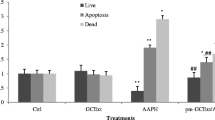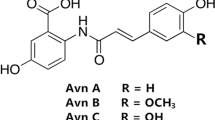Abstract
It is well known that human keratinocytes produce the anti-microbial peptide β-defensin 2. Its production is enhanced by pathogenic microorganisms or other environmental stressors. In this study, we evaluated the effect of resveratrol, a polyphenol found in several dietary source as grape seed, and its natural precursor, polydatin on heat-stressed human keratinocytes. By reverse transcription-polymerase chain reaction and enzyme-linked immunoadsorbent assay, we demonstrated that resveratrol used in combination with polydatin was able to modulate interleukin (IL)-6, IL-8 and tumor necrosis factor-alpha gene expression. In addition, our data show that resveratrol and polydatin increased the heat shock protein (Hsp)70B′ gene expression, a Hsp that plays an important role in the cytoprotection and repair of cells and tissues. Worthy of note, polydatin used alone or in combination with resveratrol, increased the release of human β-defensin 2. These results highlighted the ability of polydatin and resveratrol to reinforce cytoprotective response in stress conditions and suggest their use in cosmetic or pharmaceutical preparations.






Similar content being viewed by others
REFERENCES
Sugita, K., K. Kabashima, K. Atarashi, et al. 2007. Innate immunity mediated by epidermal keratinocytes promotes acquired immunity involving Langerhans cells and T cells in the skin. Clinical and Experimental Immunology 147: 176–183.
Medzhitov, R. 2001. Toll-like receptors and innate immunity. Nature Reviews Immunology 1: 135–145.
Barton, G.M., and R. Medzhitov. 2003. Toll-like receptor signalling pathways. Science 300: 1524–1525.
Kaisho, T., and S. Akira. 2006. Toll-like receptor function and signaling. The Journal of Allergy and Clinical Immunology 117: 979–987.
Zasloff, M. 2002. Antimicrobial peptides of multicellular organisms. Nature 415: 389–395.
Ghoreishi, M. 2000. Heat shock proteins in the pathogenesis of inflammatory skin diseases. Journal of Medical and Dental Sciences 47: 143–150.
Frankel, E.N., A.L. Waterhouse, and J.E. Kinsella. 1993. Inhibition of human LDL oxidation by resveratrol. Lancet 24: 1103–1104.
Dorozynski, A. 1997. Wine may prevent dementia. BMJ 314: 993.
Albani, D., L. Polito, A. Signorini, et al. 2010. Neuroprotective properties of resveratrol in different neurodegenerative disorders. Biofactors 36: 370–376.
Romero-Perez, A.I., M. Ibern-Gomez, R.M. Lamuela-Raventos, et al. 1999. Piceid, the major resveratrol derivative in grape juices. Journal of Agricultural and Food Chemistry 47: 1533–1536.
Falchetti, R., M.P. Fuggetta, G. Lanzilli, et al. 2001. Effects of resveratrol on human immune cell function. Life Science 70: 81–96.
Regev-Shoshani, G., O. Shoseyov, I. Bilkis, et al. 2003. Glycosylation of resveratrol protects it from enzymic oxidation. Biochemistry Journal 374: 157–163.
Sies, H. 2010. Polyphenols and health: update and perspectives. Archives of Biochemistry and Biophysics 501: 2–5.
Lanzilli, G., A. Cottarelli, G. Nicotera, et al. 2012. Anti-inflammatory effect of resveratrol and polidatin by in vitro IL-17 modulation. Inflammation 35: 240–248.
Ravagnan, G., R. Falchetti, and G. Lanzilli, et al. Solid phase extraction of trans-resveratrol from wines for HPLC analysis. Use of extracts from spermatophyte plants with immunomodulating activity. Pat EP 1292320.
Fabris, S., F. Momo, G. Ravagnan, et al. 2008. Antioxidant properties of resveratrol and piceid on lipid peroxidation in micelles and monolamellar liposomes. Biophysical Chemistry 135: 76–83.
Liu, L., A.A. Roberts, and T. Ganz. 2003. By IL-1 signaling, monocyte-derived cells dramatically enhance the epidermal antimicrobial response to lipopolysaccharide. Journal of Immunology 170: 575–580.
Elsbach, P. 2003. What is the real role of antimicrobial polypeptides that can mediate several other inflammatory responses? The Journal of Clinical Investigation 111: 1643–1645.
Nagoaka, I., F. Niyonsaba, Y. Tsutsumi-Ishii, et al. 2008. Evaluation of the effect of human beta-defensins on neutrophil apoptosis. International Immunology 20: 543–553.
Mempel, M., B.N. Kalali, M. Ollert, et al. 2007. Toll-like receptors in dermatology. Dermatology Clinic 25: 531–540. Review.
Pivarcsi, A., L. Bodai, B. Rethi, et al. 2003. Expression and function of Toll like receptors 2 and 4 in human keratinocytes. International Immunology 15: 721–730.
Giannessi, D., C. Caselli, R.L. Vitale, et al. 2003. A possible cardioprotective effect of heat shock proteins during cardiac surgery inpediatric patients. Pharmacological Research 48: 519–529.
Morimoto, R.I., and M.G. Santoro. 1998. Stress-inducible responses and heat shock proteins: new pharmacologic targets for cytoprotection. Nature Biotechnology 16: 833–838.
Manna, S.K., A. Mukhopadhyay, and B.B. Aggarwal. 2000. Resveratrol suppresses TNF-induced activation of nuclear transcription factors NF-kappa B, activator protein-1, and apoptosis: potential role of reactive oxygen intermediates and lipid peroxidation. Journal of Immunology 164: 6509–6519.
Svobodova, A., A. Zdarilova, J. Maliskova, et al. 2007. Attenuation of UVA-induced damage to human keratinocytes by silymarin. Journal of Dermatological Science 46: 21–30.
Pinnel, S.R. 2003. Cutaneous photo-damage, oxidative stress and topical antioxidant protection. Journal of the American Academy of Dermatology 48: 1–22.
Chen, M., J. Li, W. Xiao, et al. 2006. Protective effect of resveratrol against oxidative damage of UVA irradiated HaCaT cells. Journal of Central South University 31: 635–639.
Roy, P., N. Kalra, N. Nigam, et al. 2009. Resveratrol enhances ultraviolet B-induced cell death through nuclear factor-kB pathway in human epidermoid carcinoma A431 cells. Biochemical and Biophysical Research Communications 384: 215–220.
Liu, Y., F. Chan, H. Sun, et al. 2011. Resveratrol protects human keratinocytes HaCat cells from UVA-induced oxidative stress damage downregulating Keap1 expression. European Journal of Pharmaceutics 650: 130–137.
ACKNOWLEDGMENTS
This work was supported by grants from GLURES, s.r.l. Academic SPIN-OFF Ca’ Foscari University of Venice, Italy.
Author information
Authors and Affiliations
Corresponding author
Additional information
Ravagnan Giampietro and De Filippis Anna contributed equally to this work.
Rights and permissions
About this article
Cite this article
Ravagnan, G., De Filippis, A., Cartenì, M. et al. Polydatin, A Natural Precursor of Resveratrol, Induces β-Defensin Production and Reduces Inflammatory Response. Inflammation 36, 26–34 (2013). https://doi.org/10.1007/s10753-012-9516-8
Published:
Issue Date:
DOI: https://doi.org/10.1007/s10753-012-9516-8




